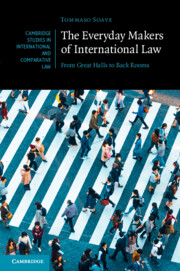Book contents
- The Everyday Makers of International Law
- Cambridge Studies in International and Comparative Law: 170
- The Everyday Makers of International Law
- Copyright page
- Dedication
- Epigraph
- Contents
- Preface
- Abbreviations
- 1 Carnegieplein 2, 10:00 am
- 2 Coffee, Cigarettes, and International Judicial Practices
- 3 A New Generation of Litigators
- 4 Telling a Story
- 5 The Invisible Army
- 6 The Three Wise Monkeys
- 7 The Lyophilization of Life
- 8 The Memo
- 9 To Capture the World
- 10 Bricolage
- 11 The Explorer
- 12 A Four-Letter Word
- 13 What Does It Mean…
- 14 The Stage
- 15 The Moment of (Constructed) Truth
- 16 Truth Woven Together
- 17 Spijkermakersstraat 9, 8:00 pm
- Index
- Cambridge Studies in International and Comparative Law
8 - The Memo
Published online by Cambridge University Press: 03 November 2022
- The Everyday Makers of International Law
- Cambridge Studies in International and Comparative Law: 170
- The Everyday Makers of International Law
- Copyright page
- Dedication
- Epigraph
- Contents
- Preface
- Abbreviations
- 1 Carnegieplein 2, 10:00 am
- 2 Coffee, Cigarettes, and International Judicial Practices
- 3 A New Generation of Litigators
- 4 Telling a Story
- 5 The Invisible Army
- 6 The Three Wise Monkeys
- 7 The Lyophilization of Life
- 8 The Memo
- 9 To Capture the World
- 10 Bricolage
- 11 The Explorer
- 12 A Four-Letter Word
- 13 What Does It Mean…
- 14 The Stage
- 15 The Moment of (Constructed) Truth
- 16 Truth Woven Together
- 17 Spijkermakersstraat 9, 8:00 pm
- Index
- Cambridge Studies in International and Comparative Law
Summary
This chapter starts to dig into the role of judicial bureaucrats as consiglieri of the court. In particular, it focuses on the memoranda they prepare to advise the adjudicators throughout the proceedings. While these internal documents go by different names and take different forms in each court, they tend to share some common features: typically, they describe and characterize the state conduct that gave rise to the case; review the facts and evidence on the record; evaluate the viability of the parties’ legal claims and defences; compile relevant case law; and provide suggestions on how the issues in dispute should be resolved. Through the preparation of memoranda, judicial bureaucrats often run a full pre-assessment of the case, thereby exerting considerable influence on the decision horizon of the adjudicators.
- Type
- Chapter
- Information
- The Everyday Makers of International LawFrom Great Halls to Back Rooms, pp. 163 - 173Publisher: Cambridge University PressPrint publication year: 2022

